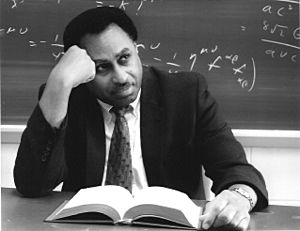Ronald Mallett facts for kids
Quick facts for kids
Ronald Lawrence Mallett
|
|
|---|---|
 |
|
| Born | March 30, 1945 Roaring Spring, Pennsylvania, U.S.
|
| Alma mater | Pennsylvania State University |
| Known for | Time travel, quantum cosmology, relativistic astrophysics |
| Scientific career | |
| Fields | Astrophysics and cosmology |
| Institutions | United Technologies University of Connecticut |
Ronald Lawrence Mallett, born on March 30, 1945, is an American theoretical physicist and author. He has been a professor at the University of Connecticut since 1975. Dr. Mallett is well-known for his ideas about the possibility of time travel.
Contents
Early Life and Inspiration
Ronald Mallett grew up in The Bronx, New York City. When he was 10 years old, in 1955, his father sadly passed away. This made young Ronald very upset. About a year later, when he was 11, he found a comic book version of H.G. Wells' famous story, The Time Machine.
This book gave him an amazing idea: what if he could travel back in time to save his father? This thought became a huge goal for him. It shaped his entire life and led to his research into time travel.
Dr. Mallett served in the United States Air Force for four years. He returned to civilian life in 1966. That same year, the science fiction TV show Star Trek began. He quickly became a big fan. He especially loved the episode The City on the Edge of Forever, which also featured time travel and lost love.
In 1973, when he was 28, Ronald Mallett earned his Ph.D. in physics from Pennsylvania State University. He also received an award for his excellent teaching that year.
Dr. Mallett is a member of important science groups. These include the American Physical Society and the National Society of Black Physicists. In 2005, he became an honorary member of the Connecticut Academy of Arts and Sciences.
Career in Physics
In 1975, Dr. Mallett started working as a professor at the University of Connecticut. He became a full professor in 1987. He has received many awards and honors for his work in academics.
His research focuses on several exciting areas of physics. These include black holes, general relativity (Einstein's theory about gravity), quantum cosmology (the study of the universe's beginnings), and relativistic astrophysics (how stars and galaxies behave at very high speeds). Of course, his main interest is time travel. As of 2025, he is a Professor Emeritus of Physics at the University of Connecticut. This means he is a retired professor who still holds an honored title.
In 2007, a radio show called This American Life shared Dr. Mallett's personal story. It talked about his lifelong dream of building a time machine.
Exploring Time Travel
Dr. Mallett's ideas for a time machine are based on Albert Einstein's general theory of relativity. This theory explains how gravity works. Dr. Mallett believes that a special kind of laser, called a ring laser, could affect space and time.
He explained that both matter and energy can create a gravitational field. This means that the energy from a light beam can also create gravity. He thought that a strong, circulating beam of light might be able to twist space and time.
Dr. Mallett suggested that if light circulates fast enough, it could create something called "closed timelike curves." These are like pathways in space-time that loop back on themselves. If these loops exist, it could allow travel into the past. He believes this could be the basis for a time machine using a circulating cylinder of light.
In 2006, Dr. Mallett wrote a book called Time Traveler: A Scientist's Personal Mission to Make Time Travel a Reality. He wrote it with author Bruce Henderson. In 2008, the famous movie director Spike Lee announced plans to make a movie based on Dr. Mallett's book. However, the movie project was never finished.
Dr. Mallett once said that his idea for time travel using light could be proven within ten years. He created a model to show how lasers could twist space and time. He also developed an equation that he believes supports his theory.
Challenges to Time Travel Research
Other scientists have looked at Dr. Mallett's ideas and found some challenges.
One concern is that the amount of energy needed to twist space and time enough for time travel would be enormous. It would require lasers much more powerful than any we have today. The ring of light would also need to be incredibly large.
Dr. Mallett explored the idea that slowing down light might reduce the energy needed. Some experiments have shown that light can be slowed down significantly by passing it through special materials. However, other physicists, like J. Richard Gott, argue that slowing light in a material is not the same as changing the fundamental speed of light in empty space. They believe it would not make time travel easier. Dr. Mallett later decided that slowing light wouldn't help reduce the energy needed for his time machine.
Another challenge comes from a theorem by physicist Stephen Hawking. This theorem suggests that it's impossible to create closed timelike curves in a finite area without using "exotic matter." Exotic matter is a type of matter with negative energy, which we don't know how to create. Dr. Mallett's original idea involved an infinitely long light source, which wouldn't break this rule. However, creating a time machine in a real, finite space would likely face this problem.
Personal Life
Ronald Mallett's brother is the artist Keith Mallett.
Books
- Time Traveler: A Scientist's Personal Mission to Make Time Travel a Reality, Dr. Ronald L. Mallett with Bruce Henderson (2006). Thunder's Mouth Press. New York.
See also
 In Spanish: Ronald Mallett para niños
In Spanish: Ronald Mallett para niños
- List of contributors to general relativity

